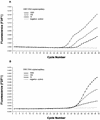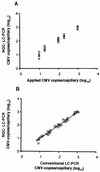Normalized quantification of human cytomegalovirus DNA by competitive real-time PCR on the LightCycler instrument
- PMID: 12454150
- PMCID: PMC154596
- DOI: 10.1128/JCM.40.12.4547-4553.2002
Normalized quantification of human cytomegalovirus DNA by competitive real-time PCR on the LightCycler instrument
Abstract
The development of a novel normalized quantitative competitive real-time PCR on the LightCycler instrument (NQC-LC-PCR) and its application to the quantification of cytomegalovirus (CMV) DNA in clinical samples are described. A heterologous competitor DNA was spiked into test samples and served as an internal amplification control. The internal control (IC) DNA in the test samples was coamplified with the CMV DNA and was tested against a calibrator sample that contained equal amounts of IC DNA and CMV reference standard DNA. An algorithm was developed to normalize possible varying amplification efficiencies between the standard and the samples. After normalization, CMV DNA copy numbers were determined in absolute terms. In a routine clinical setting, normalized quantification by NQC-LC-PCR using a single IC concentration led to results ranging from 500 to 50,000 CMV DNA copies/ml. The results obtained with conventional real-time quantification on the LightCycler instrument were almost identical to those obtained with the NQC-LC-PCR-based quantification. This was the case only for samples in which the PCR was not inhibited. With partially inhibited samples, NQC-LC-PCR was still able to correctly quantify CMV DNA copy numbers even when the PCR was inhibited by about 70%. By analyzing 80 undefined clinical samples, we found that NQC-LC-PCR was suitable for the routine assessment of CMV DNA in clinical plasma samples. Since the ICs were already added to the samples during the DNA purification, almost the entire assay was controlled for sample adequacy. Thus, false negative results were precluded. The NQC-LC-PCR approach developed should be adaptable for additional microbiological applications.
Figures





Similar articles
-
Comparison of quantitative competitive polymerase chain reaction-enzyme-linked immunosorbent assay with LightCycler-based polymerase chain reaction for measuring cytomegalovirus DNA in patients after hematopoietic stem cell transplantation.Diagn Microbiol Infect Dis. 2006 Feb;54(2):115-20. doi: 10.1016/j.diagmicrobio.2005.08.021. Epub 2006 Jan 9. Diagn Microbiol Infect Dis. 2006. PMID: 16406183
-
Automated detection of five human herpes virus DNAs by a set of LightCycler PCRs complemented with a single multiple internal control.J Clin Virol. 2004 Mar;29(3):171-8. doi: 10.1016/S1386-6532(03)00121-5. J Clin Virol. 2004. PMID: 14962786
-
Quantitation of cytomegalovirus DNA in cerebrospinal fluid and serum specimens from AIDS patients using a novel highly sensitive nested competitive PCR and the cobas amplicor CMV monitor.J Med Virol. 2004 Feb;72(2):249-56. doi: 10.1002/jmv.10538. J Med Virol. 2004. PMID: 14695666
-
Detection of cytomegalovirus (CMV) DNA in EDTA whole-blood samples: evaluation of the quantitative artus CMV LightCycler PCR kit in conjunction with automated sample preparation.J Clin Microbiol. 2008 Apr;46(4):1241-5. doi: 10.1128/JCM.01403-07. Epub 2008 Feb 13. J Clin Microbiol. 2008. PMID: 18272703 Free PMC article.
-
Detection of cytomegalovirus DNA in human specimens by LightCycler PCR.J Clin Microbiol. 2000 Nov;38(11):4006-9. doi: 10.1128/JCM.38.11.4006-4009.2000. J Clin Microbiol. 2000. PMID: 11060060 Free PMC article.
Cited by
-
Real-time PCR in clinical microbiology: applications for routine laboratory testing.Clin Microbiol Rev. 2006 Jan;19(1):165-256. doi: 10.1128/CMR.19.1.165-256.2006. Clin Microbiol Rev. 2006. PMID: 16418529 Free PMC article. Review.
-
Fully automated, internally controlled quantification of hepatitis B Virus DNA by real-time PCR by use of the MagNA Pure LC and LightCycler instruments.J Clin Microbiol. 2004 Feb;42(2):585-90. doi: 10.1128/JCM.42.2.585-590.2004. J Clin Microbiol. 2004. PMID: 14766820 Free PMC article.
-
Detection of U.S., Lelystad, and European-like porcine reproductive and respiratory syndrome viruses and relative quantitation in boar semen and serum samples by real-time PCR.J Clin Microbiol. 2004 Oct;42(10):4453-61. doi: 10.1128/JCM.42.10.4453-4461.2004. J Clin Microbiol. 2004. PMID: 15472293 Free PMC article.
-
Effect of sequence polymorphisms on performance of two real-time PCR assays for detection of herpes simplex virus.J Clin Microbiol. 2005 May;43(5):2391-8. doi: 10.1128/JCM.43.5.2391-2398.2005. J Clin Microbiol. 2005. PMID: 15872272 Free PMC article.
-
Detection and differentiation of Bordetella spp. by real-time PCR.J Clin Microbiol. 2007 Feb;45(2):347-50. doi: 10.1128/JCM.01303-06. Epub 2006 Dec 6. J Clin Microbiol. 2007. PMID: 17151212 Free PMC article.
References
-
- Al-Robaiy, S., S. Rupf, and K. Eschrich. 2001. Rapid competitive PCR using melting curve analysis for DNA quantification. BioTechniques 31:1382-1388. - PubMed
-
- Bai, X., B. B. Rogers, P. C. Harkins, J. Sommerauer, R. Squires, K. Rotondo, A. Quan, D. B. Dawson, and R. H. Scheuermann. 2000. Predictive value of quantification PCR-based viral burden analysis for eight human herpesviruses in pediatric solid organ transplant patients. J. Mol. Diagn. 2:191-201. - PMC - PubMed
-
- Benedetti, E., M. Mihalov, M. Asolati, J. Kirby. T. Dunn, V. Raofi, M. Fontane, and R. Pollak. 1998. A prospective study of the predictive value of polymerase chain reaction assay for cytomegalovirus in asymptomatic kidney transplant recipients. Clin. Transplant. 12:391-395. - PubMed
Publication types
MeSH terms
Substances
LinkOut - more resources
Full Text Sources
Other Literature Sources

